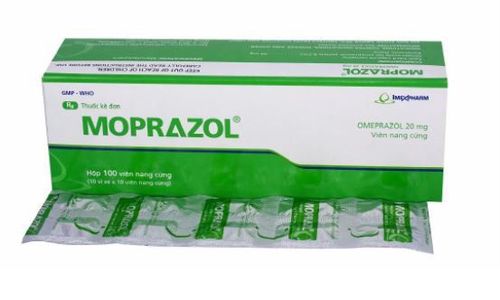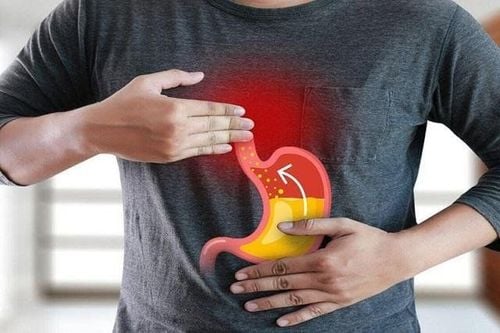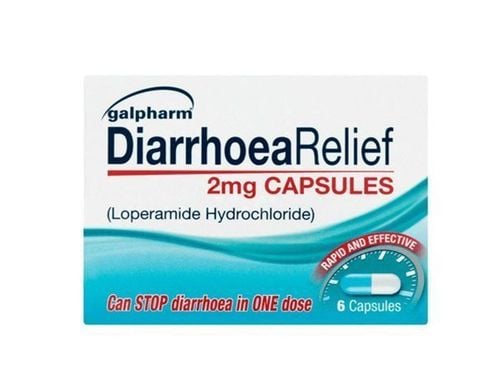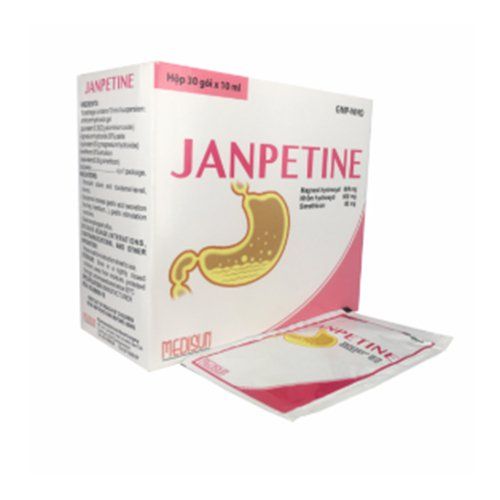This is an automatically translated article.
Moprazol is one of the drugs that many patients with gastroesophageal reflux disease, or gastric and duodenal ulcers are most interested in today. Read the article below to learn more about what moprazole is, what are the uses of moprazole 20mg, and how to use moprazole 20mg.
1. What is moprazole?
Moprazol is being produced domestically and is currently being widely distributed at many pharmacies across the country. Currently, the drug oprazol 20mg is being made in the form of capsules containing the active ingredient omeprazole 20mg. Moprazol 20mg contains a group of anti-inflammatory compounds that prevent gastric acid secretion, thereby helping to heal ulcers and protect the stomach.
Moprazol box of 100 tablets is a product that is being trusted and widely used today, because Moprazol box of 100 tablets with Omeprazole ingredients is used in the treatment of gastroesophageal reflux syndrome - oesophagitis, GERD, ulcer treatment. Very good digestive tract.
1.1. Pharmacokinetics/Pharmacodynamics of moprazole 20mg Pharmacokinetics Moprazole 20mg is completely absorbed into the small intestine within 3 to 6 hours after oral administration. Bioavailability is about 60%. The absorption of moprazole is not affected by food or other factors in the stomach. The absorption of omeprazole is dose dependent only and may increase absorption and bioavailability if there is inhibition of gastric acid secretion. Moprazole is highly bound to plasma proteins (about 95%) and is distributed to body tissues, especially to parietal cells of the stomach.
The bioavailability of the first single oral dose is about 35%, but increases to about 60% with subsequent daily dosing. Although the elimination time of moprazole 20mg is short (about 40 minutes), the inhibitory effect on acid secretion is long, so it can be used only once a day.
Moprazole is almost completely metabolised in the liver, rapidly eliminated, mainly in the urine (80%), the rest is excreted in the feces. The metabolites of the drug are inactive but interact with many other drugs by inhibiting the cytochrome P450 enzymes of hepatocytes.
The pharmacokinetics of moprazole 20 mg are not altered in the elderly or in patients with impaired renal function. However, in subjects with impaired hepatic function, the bioavailability of moprazole 20 mg was increased and the clearance decreased.
There is no accumulation of moprazole and its metabolites in the body.
Pharmacodynamics Moprazole 20mg inhibits gastric acid secretion in patients by reversible inhibition of the hydrogen-potassium adenosine triphosphatase enzyme system in the parietal cells of the stomach. This inhibitor has a rapid, long-lasting but reversible effect. However, omeprazole has no effect on acetylcholine receptors or histamine receptors, so moprazole 20mg reaches its maximum effect 4 days after taking the drug.

Thuốc Moprazol 20mg có tác dụng giúp làm lành vết loét, bảo vệ dạ dày
2. Some uses of Moprazol 20mg
Moprazol 20mg medicine is used to treat cases of gastrointestinal diseases such as:
Gastroesophageal reflux disease (GERD) Esophageal acid-related damage to the esophagus Stomach ulcers or duodenal ulcer (a duodenal ulcer that occurs in the first part of the small intestine, which is connected to the stomach) Zollinger-Ellison syndrome is a condition that results from the presence of one or more tumors in the duodenum or pancreas. Stomach infection caused by Helicobacter pyloribacteria ( H. pylori ). Contraindications to moprazole 20mg:
Moprazole should not be used in patients who are allergic to omeprazole or any other ingredient of moprazole. Moprazole should not be used in patients who are allergic to other proton pump inhibitors (eg, pantoprazole, lansoprazole, rabeprazole, esomeprazole). Moprazol should not be used by patients who are taking drugs containing nelfinavir that are used in HIV-infected patients.
3. How to use moprazole 20mg
Before using moprazol 20mg, patients need to completely eliminate H. pylori and reduce or stop taking non-steroidal anti-inflammatory drugs to be able to heal long-term scars and avoid recurrent ulcers.
3.1. Use for patients with esophagitis caused by gastroesophageal reflux - oesophagitis The usual dose for patients with esophagitis due to gastroesophageal reflux disease is 20-40mg, taken once a day/20-40mg , the duration of treatment is from 4 to 8 weeks; After that, the patient used a maintenance dose of 20mg/time/day.
Treatment of gastric and esophageal ulcers: The dose of moprazol for duodenal ulcer patients is 20mg (40mg can be used in severe cases) for 4 weeks and for 8 weeks if the patient has stomach ulcers. Patients should not use it for a longer time than using moprazole. Treatment with moprazole 20 mg reduced gastric acidity but resulted in a temporary and reversible increase in gastrin.
When treating gastric and esophageal ulcers for many days, patients are prone to experiencing gastric cyst proliferation. These changes are physiological, benign, and reversible. The inhibitory effect of moprazole 20 mg protonation is covariable with the area under the concentration and time curves, not merely with moprazole plasma concentrations. When using moprazole 20 mg will reduce the production of HCl within 2 hours.
If the patient takes moprazole 20 mg for several days, taking it once a day, the maximum effect will be achieved after 3-5 days. Because the patient's gastric acidity decreased by an average of 80% and the production of HCl stimulated by pentagastrin was also reduced by 70% after taking moprazol 20 mg within 24 hours. Moprazole 20 mg inhibits the secretion of HCl and this effect disappears after stopping the drug for 5 days. Moprazole 20 mg relieves symptoms at the first dose after oral administration, and within 2 weeks in most patients with duodenal ulcer. In people with peptic ulcer and reflux esophagitis, on average, after 4 weeks of using moprazole.
If the patient does not eradicate H. pylori and if the use of non-steroidal anti-inflammatory drugs is not reduced or stopped, the recurrence rate will be high, because non-steroidal anti-inflammatory drugs inhibit the synthesis of prostaglandins required for maintenance. protect the gastric mucosa.
To kill H. pylori bacteria, the patient should use the antibiotic amoxycilin (or tetracycline) + metronidazol (or tinidazol) for 10 days. In addition, patients should take moprazole at the same time as amoxicillin, because taking moprazole first will reduce the effect of both drugs. The simultaneous use of 3 drugs often causes more unwanted side effects, but these undesirable effects are all mild. Besides, before choosing a treatment plan, the specialist will have to take into account the antibiotic resistance of H. pylori bacteria. If the patient is taking a high dose for treatment, the drug should not be stopped suddenly but must be gradually reduced.

Người bệnh bị loét dạ dày - thực quản cần sử dụng thuốc Moprazol theo chỉ dẫn
3.2. Treatment of Zollinger - Ellison syndrome: Patients take once moprazol 60mg/day (20-120mg daily); If the dose is higher than 80mg, it should be divided into 2 times a day, and the dose of moprazole should be calculated on a case-by-case basis and the treatment can be prolonged depending on the doctor's request. Patients must not stop taking the drug on their own, do not use the right duration of moprazol.
4. Side effects of moprazole 20mg
Using moprazol 20mg has a few mild side effects, such as: Constipation, flatulence, nausea, vomiting, headache, rash. Some skin symptoms such as: hives, itching, swelling; sore throat, difficulty breathing or swallowing, hoarseness. Other serious but uncommon symptoms include: irregular heartbeat, extreme fatigue, dizziness, muscle spasms, uncontrollable shaking of a part of the body (mild paralysis). In addition, in rare cases, patients using this drug are at greater risk of fractures of the wrist, hip, or spine than others.
Or contact a specialist if you have any unusual problems while taking moprazole.
5. Be careful when using moprazole 20mg
First of all, patients will be asked or checked if there is a malignant tumor, if there is a specialist, they will exclude the use of moprazol 20mg.
In critically ill patients and those with multiple ulcers, intravenous injection should be given slowly for at least 3 minutes, up to a maximum rate of 4 mL/min to prevent stress ulcer bleeding. With a dose of moprazole 40mg intravenously, it will immediately reduce the amount of hydrochloric acid (HCl) in the patient's stomach after 24 hours.
For children: The safety and effectiveness of moprazole 20mg have not been established in patients under 1 year of age. For the elderly: Care should be taken when administering moprazole 20mg to the elderly because the sensitivity to this drug may be greater. For patients with hepatic impairment and of Asian descent, a dose reduction of moprazole 20 mg should be considered. 5.1. Interactions with other medicinal products of moprazole 20mg No clinically important interactions have been observed when moprazole is administered with food, alcohol, amoxycillin, bacampicillin, caffeine, lidocaine, quinidine or theophylline, or concomitantly. with maalox or metoclopramide.
Moprazol 20mg may increase blood levels of ciclosporin.
Moprazol 20mg drug increases the effect of antibiotics to eradicate H. pylori. Moprazole 20mg inhibits the metabolism of drugs metabolized by the liver cytochrome P450 enzyme system and may increase blood levels of diazepam, phenytoin and warfarin. The reduced metabolism of diazepam makes the drug's effects last longer. At a dose of 40 mg/day omeprazole inhibits phenytoin metabolism and increases blood levels of phenytoin, but a much weaker interaction with omeprazole 20 mg/day. Moprazole 20mg inhibits the metabolism of warfarin but has little effect on bleeding time.
Moprazol 20mg increases the anticoagulant effect of dicoumarol.
Moprazole 20mg reduces the metabolism of nifedipine by at least 20% and may increase the effect of nifedipine. Clarithromycin inhibits the metabolism of omeprazole and doubles the concentration of omeprazole.

Người bệnh thận trọng vì Moprazol có thể tương tác với một số thuốc khác
It is best to inform the doctor or pharmacist about the patient's condition, symptoms of side effects and information about current disease, medical history, allergies, pregnancy, lactation...
Before taking medicine, always consult your doctor or pharmacist to weigh the benefits and risks of taking the drug while pregnant.
Look up the US Food and Drug Administration (FDA) classification of drugs for use in pregnancy below:
A = No risk;
B = No risk in some studies
C = Possible risk;
D = There is evidence of risk;
X = Contraindications;
N = Still unknown.
Care should be taken in taking moprazol 20mg and carefully read the instructions for use, or consult a specialist doctor.
Vinmec International General Hospital is one of the hospitals that not only ensures professional quality with a team of leading medical professionals, modern equipment and technology, but also stands out for its examination and consultation services. comprehensive and professional medical consultation and treatment; civilized, polite, safe and sterile medical examination and treatment space.
Please dial HOTLINE for more information or register for an appointment HERE. Download MyVinmec app to make appointments faster and to manage your bookings easily.













